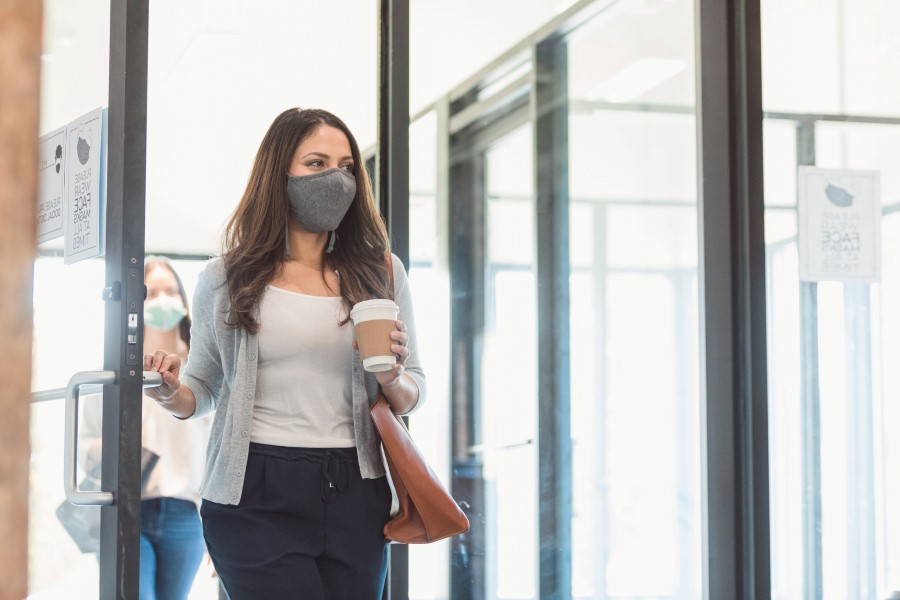
Employers are facing an uphill battle in luring remote workers back to the office.
A third of employees now exclusively work remotely and many are reluctant to return to the workplace, it emerged at our webinar, The Big Return, last week.
“The majority of people don’t want to go back,” said Tracey Browne, Ai Group’s National Manager – Safety & Workers' Compensation Policy & Membership Services.
“That’s become very clear. Meanwhile, questions around productivity and collaboration are no longer relevant as people can be in the office, at home or somewhere else and still have an effective meeting.”
Flexibility, mental health, communication and compliance were identified in the webinar as the top four issues employers need to address for a positive and productive return to the workplace.
Staff need to feel healthy and safe on the return and there needs to be sufficient purpose in going back.
Organisations also need to recognise that employees have had vastly different experiences over the past two years, depending on their roles.
“It’s easy for a person who has worked effectively from home for two years to argue that they should be allowed to continue to do so, but how does that sound to the person who has been working on the factory floor producing hand sanitiser, hoping not to catch COVID-19 and take it home to their family while others didn’t have to leave home?” Ms Browne said.
“For many organisations, the majority of workers have continued to attend worksites every day during the various lockdowns that we have had around the country.
“For those businesses, it may not be so much The Big Return but trying to get the minority of workers who are still working from home full-time back into the workplace.”
Flexibility has never been more important than now with only 15-20% of employees based in the office, 30% working remotely and 50% adopting a hybrid format.
“Employee turnover will continue as people decide how, where and when to work,” fellow presenter Catherine Dawson, Ai Group’s Principal Adviser, HR Consulting Services, said.
“They will go to a workplace that accommodates their individual needs. If you don’t accommodate them, you may lose them. That’s what we’re seeing across the board.”
Innovative ways to build better remuneration packages are needed to stem “The Great Resignation”.
“You may need to look at how the package of a job is put together,” Ms Dawson said.
“Is it a shorter work week? Is flexibility part of it? Some places are using that as a leveraging tool to get people on board or to retain their people.”
Once staff return to the workplace, they need a reason to stay.
“If someone makes a big effort to go back to the office and there is no one in there and all they’re doing is looking at a screen all day, then why would they think that is a purposeful way to spend their day?” Ms Dawson said.
“Having that clear purpose is important. What’s in it for them?
“You’re missing the point if you think: ‘they only live 15 minutes away from work, what’s the difference?’
“The difference is that when they are at home, they can do little tasks throughout the day while they get up and stretch. It makes a big difference to some people’s lives.
“Other remote workers might save two hours in transit time, so why is it in their best interest to go in?”
Establish what part of a worker’s role requires them to be at the workplace.
“The design of the role may not have been captured in the position description before, but maybe it needs to be captured now about what needs to happen on a day-to-day basis in the working life of that person and how they interact physically with people in other parts of the business.”
It is important to give workers options about The Big Return, even if it’s a phased-in approach to get them back to where you want them to be.
“All or nothing doesn’t seem to be working,” Ms Dawson said.
“That’s why there seems to be some clear resignations across the board because people aren’t liking what’s being presented to them. Ask people what will work.
“Say to them: ‘If you do want to work from home and these are the tasks that you need to do, help me understand how that’s going to work.
“Put it back on the employee then embrace a hybrid approach, even if it’s for a short time to get to a period where you are more satisfied with the presenteeism of people in the office.”
Research by Allianz shows psychological health claims have jumped by 5% in the past financial year and that the average cost of psychological damage is 3.5 times higher than physical injuries.
At the same time, the number of Australian workers who work from home (WFH) has increased from 8% to 40% in less than two years, according to the Productivity Commission.
“The same report has also shown that WFH increases the risk of work impinging on non-working life,” Trinette Jaeschke, Ai Group’s National Manager – Work Health Safety Consulting Services, said.
“This means the lines between work and home are becoming even more blurred with WFH affecting the ability of some workers to switch off from work. Potentially, this has detrimental effects on stress levels, interpersonal relationships and work productivity as well as presenting risks to mental health.”
The State of Wellbeing in Australian Workplaces Report by AHRI & The Wellbeing Lab in 2020 revealed 82% of workers were anxious about the impact of COVID-19 and 76% were uncertain about actions to take at work.
“Even though these results were at the start of COVID-19 restrictions, it shows how important it is for us to address any change,” Ms Jaeschke says.
“When change happens, people’s stress levels rise and their ability to cope further reduces. Returning to the workplace after so much unrest requires us to be vigilant and to consider all the changes that returning to the office brings.”
Support workers by understanding their current needs and give them tools to cope with stress.
Offer flexibility and build relationships. One in five workers believes they don't have anyone to confide in, with 44% of these workers admitting they are not coping.
“We need to consider how workplace dynamics influence the psychological health of our workers,” Ms Jaeschke says.
Communication is key to helping people understand what is going on in the workplace.
“It’s about having good, informed discussions,” Ms Dawson said.
“If people don’t have information, it creates anxiety and mistrust, so utilise the many platforms available to you.
“People feel they can speak up and ask about things that are concerning them if you have created an environment where that can happen.
“People resist if there is something worrying them, so they need to be able to articulate what is on their mind and feel there is no recourse in voicing their opinion.”
What does communication in your organisation look like? When was the last time managers made contact just to see how people were doing? When did you last have a 1:1?
“Vary the modes and frequency of communication,” Ms Dawson said.
“It doesn’t have to be all town halls; it could be 1:1s, cross-team catch-ups or aligning buddies and mentors. Employees must be engaged to be part of The Big Return.”
Meanwhile, leaders need support in building their remote management capabilities.
“There were some people who were happy to go back to the office so they could go back to their normal management style because that was their comfort zone,” Ms Dawson said.
“It’s true — learning to manage remotely is different, so learn and embrace the skills needed to do this effectively.
“Upskilling is important, but you also need to ask your people how they want to be managed. The answers are within your people.”
Get up to speed on safety legislative compliance and consider what areas you need to address for a smooth return to the workplace.
Recognise the changes that have occurred with COVID-19 impacting the workplace and ensure workplace systems have adjusted. For example, now that people are back in the workplace, check your emergency personnel listed are current and still available (even in a hybrid work environment) and your preventative maintenance schedules have picked up again now we are back in the physical workplace.
“There is a sustained responsibility on the employer to keep the workplace COVID-safe,” Ms Browne said.
“COVID-19 is a WHS issue, and it will continue to be so. We need to make sure that just because we don’t have legislative requirements and public health orders (PHOs) anymore that we don’t drop the balls in our workplaces.”
Consultation remains essential when it comes to addressing COVID-19 control measures.
The goal is to make workers feel healthy and safe on their return to the workplace.
“Use all the tools that you have,” Ms Browne said.
“Keep your lines of communication open and share successful return stories. Ensure hardware and software work and that people know how to use them so they are not left behind.”
Click here for our COVID-19 services and the latest advice or visit our Human Resources Centre.

Wendy Larter is Communications Manager at the Australian Industry Group. She has more than 20 years’ experience as a reporter, features writer, contributor and sub-editor for newspapers and magazines including The Courier-Mail in Brisbane and Metro, the News of the World, The Times and Elle in the UK.